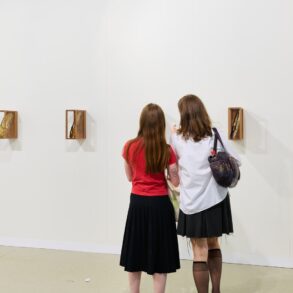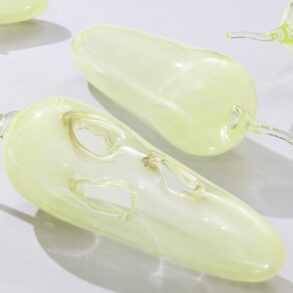JENNIE C. JONES was a 20-year-old art student when she first saw the work of the minimalist painter and sculptor Ellsworth Kelly installed at the Art Institute of Chicago in 1989. These were some of Kelly’s signature panels: bold, monochromatic shapes of saturated color in oil on canvas. They were flat like paintings but sculptural in their defiance of right angles. Jones recalls being struck most of all by what Kelly’s work displaced. It occupied the second floor of the museum’s two-story sculpture court, which had been redesigned the previous year to showcase classical sculpture and painting. “They took down all these other artists to put up this suite,” Jones says. “I was so secretly envious that Kelly was able to hold that space.” Such freedom claimed by a renowned white male artist stood in contrast to her own growing sense as a young Black woman artist of being pigeonholed, of that same freedom — of space, of form — not being available to her.
Today, Jones, 55, is a celebrated minimalist whose work on paper and canvas, in sculpture and sound, is scrupulously reduced to its geometries, its tones, its colors. Next April, she will take over the Metropolitan Museum of Art’s roof garden, where she’ll debut her first multiwork outdoor sculptural installation. She occasionally paints in acrylic directly onto acoustic panels, sometimes in muted grays and whites that very nearly appear to blend into the wall. Seeing Kelly’s radical reductivism on such a grand scale was a provocation, one that redirected her trajectory. “Where am I in this story?” Jones thought. Over time, she found answers, both in the work of artists like Kelly and in what she calls “alternative origin stories” through which she traced her nascent interest in minimalism to the Black diasporic tradition, from Gabonese masks and Cameroonian mud huts to Miles Davis’s spare solos performed with his back turned to the audience.

JONES IS ONE of several contemporary Black women artists for whom minimalism — long marked by its hypermasculinity and by the conspicuous absence of nonwhite artists — has unexpectedly become an expressive language in which they are fluent but don’t always, or only, choose to communicate. The first wave of minimalism in America emerged as a postwar avant-garde that sought to extinguish artist subjectivity in favor of the object — a rejection of the excesses of self-expression and of the cult of genius that had come to define Abstract Expressionism and other movements of the 1940s and ’50s. In response to political polarization, economic instability and war, minimalists in the 1960s called for austerity and a return to aesthetic first principles: A work of art should reveal nothing more than itself; or as Frank Stella put it in 1966, “What you see is what you see.” Minimalism embraced cheap, mass-produced materials — plywood, granite, brick, metal — in order to, in the late Carl Andre’s words, “get down to something which resembles … some kind of blankness.” One of the most famous works of minimalism is Andre’s “Equivalent VIII” (1966), an arrangement of 120 firebricks, about which the artist told the BBC, “My work doesn’t mean anything.”
Drawing upon a minimalist vocabulary of object and image, Jones and her peers often bring to bear a more personal and expressly political set of conceptual and aesthetic aims. Aria Dean, 30, a New York-based sculptor and theorist who crafts “objects that speak to the truth of the process of their coming into being,” cites the influence of Robert Morris, who used basic carpentry techniques to argue that art should allow “the spectator to focus on their physical relationship to the work, the particularity of its space of encounter in real time.” Bethany Collins, 39, who lives in Chicago, occasionally makes simple shapes on handmade paper that have been compared to the work of Agnes Martin; she also recently completed a series titled “Old Ship,” in which she uses pink granite dust from the base of a dismantled Confederate monument in Charlottesville, Va., to forge three-dimensional forms on canvas inspired by architectural details from the Old Ship A.M.E. Zion Church in her hometown, Montgomery, Ala. Nikita Gale, 40, lives in Los Angeles and uses manufactured materials that riff on the legacies of Andre and Michael Heizer. In her 2022 exhibition “End of Subject” at New York’s 52 Walker gallery, everyday objects like barricades became metonyms for the ways in which individuals organize, divide and view one another in social settings.
This post was originally published on this site be sure to check out more of their content







